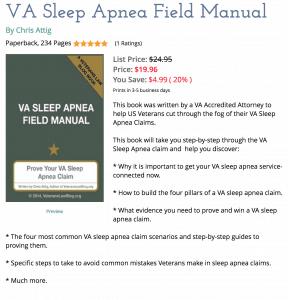I read Veterans Court cases every day – and they often get me thinking.
Not too long ago, I read a case in which a Veteran got the VA to issue a decision on his Remanded appeal in 56 days – while losing his Veterans Court case at the same time.
Because of the unique nature of his Court appeal – which he lost – he actually won.
And won big, from all appearances.
You can read the single-judge decision in Gulley v. Gibson, here.
How did the Veteran get a decision from the VA in 56 days? He filed what the Court commonly calls a Writ – there are many “writs” in the law, but this one is called the Petition for Writ of Mandamus.
We’ve talked about Writs before here on the blog.
You can get up to speed on the elements of a Writ here – in “human-speak” a Writ is a request that the Court tell the Executive Branch to act in a particular case.
Here’s how the Veterans Writ of Mandamus Played Out.
Keep in mind, as you read this, that when the Court and/or Board issue a Remand, the Veteran is supposed to get the benefit of expedited relief on Remand.
Expedited Relief on Remand is one of those rules that nobody wants to really follow or enforce – neither the Court, nor the BVA, nor the VBA really adhere to it, and I could find only one Court decision – in 3+ decades – that took the VA to task for not expediting a matter on remand …as many Veterans appeals disappear into a Black Hole of Remands for years and years and years…..
June 2011: Vet gets a Remand Order from the Veterans Court in his service-connection claim.
January 2012: BVA issues a Remand to the Regional Office.
March 2012: VA Regional Office starts poking around for medical records in March 2012.
March 2012 – July 2013: Crickets.
July 2013: 25 months after the Court issued a Remand, the VA starts poking around for those medical records it requested 16 months earlier.
So much for “expedited relief” — or so says the Vet.
He heads back to the Veterans Court and files a Petition for Writ of Mandamus June 5, 2014.
By July 17, 2014, the VA is promising that the C&P will be conducted and the decision issued by July 31, 2014.
56 days to get a decision. You read that right – 56 days!
That’s some damn fine turn-around time from the Little Rock Regional Office.
Truth be told…. I’ve always liked the Little Rock RO…nice folks there every time I talk to them.
I also have to say that there is NO reason – NO reason under the sun – that right now the VA Regional Offices can’t make decisions on all claims and appeals in under 60 days.
The ones that don’t merely lack the will or the motivation – and that’s not a “dig” – it’s a factual observation.
Shortly after his victory, though, the Veteran’s Petition for a Writ was denied.
Why?
The Veterans Court is fond of tossing around what it calls the Doctrine of Mootness – this is the idea that if the VA takes action in response to a Petition for Writ of Mandamus, that action moots the Writ.
In other words, if the VA does something, the Court doesn’t have to do anything anymore.
I have 2 concerns with the Doctrine of Mootness, as applied by the Veterans Court.
First, the Doctrine of Mootness has exceptions that the Veterans Court has never been forced to confront. Chief among them is the idea that a wrong is not moot when it is “capable of repetition yet evading review”, and a wrong is not “moot” unless there is no reasonable expectation that the wrong will be repeated.
Another example is that the VA taking action to moot a Petition for Writ of Mandamus does not eliminate the constitutional case and controversy that almost invariably should accompany the Writ.
The Veterans Court has had a fairly easy go of things in its early history – as the number of attorneys practicing Veterans Law increases, I predict there will be a rise in the number of constitutional challenges to certain Agency and certain Court actions – questions that an Article I Court (i.e., a legislative Court) may not have authority to hear.
Federal Courts derive their authority from 2 places in the American System. Article III Courts are the traditional Federal Court System, and their authority flows from the Constitution. Article I Courts are courts of “special jurisdiction” created by Congress – their authority flows from a legislative act or a statute. Crassly speaking, Article III Courts are the NFL. Article I Courts are the USFL. They are both football, but not really.
But as is too common the case, I digress.
If They are Always Getting “Mooted”, Why is the Petition for Writ of Mandamus so Effective?
Petitions for Writ of Mandamus at the Veterans Court are effective because nobody wants to talk about the Elephant in the Room.
Here’s what the various players would have to talk about if they were to ever decide a “Writ”:
VA: They’d have to demonstrate what IS a reasonable amount of time for a Veteran to wait for VA action – and then hold true to their word to avoid future problems. The VA is so scared of this argument it will move heaven and earth to take action and moot the Writ.
Exhibit A: In the Veteran’s case, above, the Veteran filed for the Writ on June 5, 2014; the VA committed to gathering medical evidence, scheduling a C&P and issuing a decision on the Remand Order in 56 days – by July 31, 2o14.
COURT: No Judge wants to write a decision saying how long is a reasonable period of time for a Veteran to wait for action. And most assuredly not a Judge in an Article I Court: such an action would invariably be seen as both a check – an attack, if you will – on the Executive branch by a non-Article III Court, or, as some court observers point out, encroaches on the role of Congress.
Even beyond that, the Veterans Court is in, as they say, a bit of a pickle.
The prospect of issuing a Writ is, to the Veterans Court, akin to what “Texting While Driving” is to the driver of an 18-wheeler – the minute you start typing, the minute you should know you are going to make a huge mess.
In the Gulley decision, the Court was gentle in its denial of a Petition for Writ of Mandamus: “although the Court understands the [Veteran’s] frustration, the delay involved must be unreasonable before a Court will inject itself [into the VA’s process].”
VETERAN: This poor guy doesn’t even really care – he’s just using the process because it’s there. He just wants a darn decision in his case – he may just need to make a house payment or keep the lights on another month – he doesn’t want to waste time arguing what timelines are reasonable. Especially not after wasting years dealing with dilatory and borderline ridiculous and unsupported arguments at the VBA, the BVA, and before the Office of General Counsel.
From what I can tell from the limited docket available online in this case, the Veteran did exactly what he needed to: he argued just enough about how the “Board seems to have indefinitely delayed the proceeding of [the] case, no the strength of being backlogged, with no specific time frame set for deciding [the] claim”. That argument, right there, is the first domino that sets the rest falling.
What do all these arguments have in common?
For very different reasons, all the players in this game want to avoid a debate over what is, and is not, a reasonable amount of time for a Veteran to wait for the VA to take action.
There is a Storm Brewing at the Veterans Court Over the Writ Process.
In a 2014 single judge decision, Hamblin v. Gibson, the Court talked about the so-called “Writ Effect” and how the Veteran wins by losing:
The Veterans Court said: “…the RO has adjudicated the petitioner’s claims at issue only after a petition has been filed, which creates a perception that incentivizes the filings of petitions and burdens the Court.”
Listen to the subtext here – the Court is telling Veterans to bear the burden of what is sometimes a decade long wait for benefits rather than suggest that the Veterans Court might bear the burden of adjudicating Petitions for Writ of Mandamus. When I read that line, here’s what I heard: “You wait. We don’t have the resources to help Veterans.” Is that what the Court intended to say? Is it an objectively reasonable interpolation? I don’t know…but as a Veteran, that just about amounts to a slap in the face.
Not every Judge agrees with this conclusion.
One Judge, in a dissent in the Young case a couple years back, suggested that, if a Veteran was not satisfied with a Board Referral decision, that Veteran could use the Writ Process to get “…expedited processing more quickly than a successful appeal to the Court.”
(Note: A Referral Decision from the BVA is NOT a Remand Decision – the BVA refers cases back to the Regional Office when it feels it doesn’t have jurisdiction. It remands when it needs to develop more evidence to make a decision.)
In other words – and I could be way off base here – there appears to be a growing schism in the Court over Writs: the Young dissent seems to encourage the very Writ process that the Hamblin Court is wanting to discourage.
Some of my friends in the Veterans’ Bar have taken issue with the statement of the Veterans’ Court in the Hamblin decision: many attorneys see it as an attack on Veterans for using the legal tools available to get the relief that they need.
Maybe those attorneys are right.
For a system that is designed to help those that “bore the battle”, there is an awful lot of anger at Veterans at the VBA, the BVA and the VA OGC.
Or maybe the Hamblin verbiage was just a shot across the bow – a warning if you will.
My question is this – to whom was that “warning shot” directed?
Maybe it was a warning to the Executive Branch: when the Veterans Court sees you – time and time again – issue a decision in 56 days under “threat of writ”, it is frustrated that THEIR docket is clogged with claims taking YOU 3 years.
Maybe it was a warning to Congress: fixing the rules of this process is your “gig”. The Court isn’t going to exhaust its resources while you sit idly by and don’t rein in this dysfunctional system.
Or maybe it wasn’t a warning at all. Courts often know their own limitations and, as suggested above, maybe this Court is aware of its own – though neither the OGC nor the Veterans Bar seem to have pieced it all together yet.
But in the end, does it matter who it’s warning?
Everybody seems really content with the stalemate:
1) Congress isn’t going to act; the last time a Court sent the Legislature a “hint” in a Veteran’s Writ Case that actually worked – near as I can tell – was in Hayburn’s Case in 1792.
2) The VA is never going to willingly change its own adjudication process….more than that, though, the actions it told the Hamblin Court it was taking are, largely, going to have NO effect on claims processing times and the Veterans Court won’t remember this in 2 years or 5 years or 10 years.
3) Veterans will continue to file Writ Petitions since they work
What will break the stalemate is the private bar – say what you will about attorneys, but historically, we are the defenders and champions of justice.
Eventually, we will push for a Judicial check and balance on the VA Hamster Wheel….. maybe a Veteran will come into Court in with a set of facts that becomes a tipping point and a Writ of Mandamus will have to issue …. or an Article III court will issue the Writ that an Article I court won’t…. or maybe someone will try to Mandamus the Veterans Court.
Whatever way the pendulum swings, isn’t it time to start challenging the status quo when it comes to the Petition for Writ of Mandamus?






